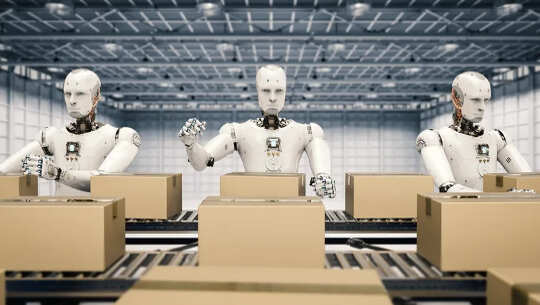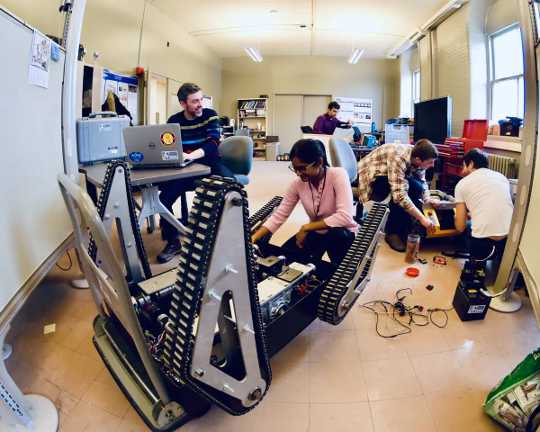
The future of automated labour may not spell the end of human employment. (Shutterstock)
In 2017, I returned to Canada from Sweden, where I had spent a year working on automation in mining. Shortly after my return, the New York Times published a piece called, “The Robots Are Coming, and Sweden Is Fine,” about Sweden’s embrace of automation while limiting human costs.
Although Swedes are apparently optimistic about their future alongside robots, other countries aren’t as hopeful. One widely cited study estimates that 47 per cent of jobs in the United States are at risk of being replaced by robots and artificial intelligence.
Whether we like it or not, the robot era is already upon us. The question is: Is the Canadian economy poised to flourish or flounder in a world where robots take over the tasks we don’t want to do ourselves? The answer may surprise you.
Robots are everywhere
Modern-day robots are how artificial intelligence (AI) physically interacts with us, and the world around us. Although some robots resemble humans, most do not and are instead specifically designed to autonomously carry out complex tasks.
Over the last few decades, robots have rapidly grown from specialized devices developed for select industry applications to household items. You can buy a robot to vacuum your floors, cut your grass and keep your home secure. Kids play with educational robots at school, where they learn to code, and compete in robot design teams that culminate in exciting international competitions.
Robots are also appearing in our hospitals, promising to help us fight the COVID-19 pandemic and performing other health-care tasks in safer and more efficient ways.
Making Sense of the Robotized Pandemic Response - a new white paper by ?@UofTRobotics? comparing technology readiness levels and success factors of robots across numerous pandemic use cases / Includes both global and Canadian contexts https://t.co/U5pLGIl6dK
— University of Toronto Robotics Institute (@UofTRobotics) September 21, 2020
The media is abuzz with stories about the latest technical claims, rumours and speculations about the secret developments of major international corporations, including Waymo, Tesla, Apple, Volvo and GM.
And NASA just landed the Perseverance rover on Mars, with an autonomous helicopter called Ingenuity attached to its belly.
Oh, and there are the dancing robots too, of course.
Robots behind the scenes
I have been working on robotics and autonomous vehicles technology in mining since the late 1990s. As such, I have been part of an industry that is undergoing a sea change, with fully autonomous machines steadily replacing workers in dark, dirty and dangerous scenarios.
 A fully autonomous underground load-haul-dump vehicle developed for Swedish mining equipment manufacturer Epiroc AB and in partnership with Canadian robotics firm MacDonald, Dettwiler and Associates. (Joshua Marshall), Author provided
A fully autonomous underground load-haul-dump vehicle developed for Swedish mining equipment manufacturer Epiroc AB and in partnership with Canadian robotics firm MacDonald, Dettwiler and Associates. (Joshua Marshall), Author provided
This robot revolution is happening behind the scenes in other industries too. Robots fill Amazon orders, manufacture stuff in factories, plant and pick crops, assist on construction sites, and the list goes on.
In fact, robots even build other robots. Will we soon run out of jobs for people?
Robots in Canada
There are many who paint a bleak picture of the future, where robots and AI take away all the “good jobs.” Although I fully acknowledge that we must be mindful of possible inequalities and unintended outcomes that might arise as a result of new technologies, I contend that Canadians have the potential to thrive.
But to make it happen, my colleagues and I agree that our country needs a “robotics strategy.”
In 2017, Canada launched the world’s first national AI strategy. Called the Pan-Canadian Artificial Intelligence Strategy and costing $125 million, the strategy aims to strengthen Canada’s leadership in AI by funding institutes, universities and hospitals to meet key objectives.
In its 2020 list of future jobs, the World Economic Forum listed “robotics engineers” as No. 10, in close company with “AI and machine learning specialists.” In Canada, I see huge potential for our robotics industry, with companies such as Clearpath Robotics, OTTO Motors, Kinova, Robotiq and Titan Medical already world leaders in the design and manufacture of robots for purposes ranging from materials handling to surgery.
Beyond building robots, Canada’s most significant opportunities may lie in the increased adoption of robots into economically important industry sectors, including mining, agriculture, manufacturing and transportation.
And yet, Canada may be the only G7 country without a robotics strategy.
The robot revelation
As it turns out, there is hope. According to a November 2020 report from Statistics Canada, Canadian firms that employed robots have also hired more human workers, contrary to what you may instinctively believe. In fact, they hired 15 per cent more workers!
However, this does not mean that we can all sit back and relax. Along with the increased economic activity that robots bring to businesses comes a shift in the workforce from “workers spending less time performing routine, manual tasks, in favour of non-routine, cognitive tasks.”
 Mobile robotics researchers from the Ingenuity Labs Research Institute at Queen’s University. (Heshan Fernando), Author provided
Mobile robotics researchers from the Ingenuity Labs Research Institute at Queen’s University. (Heshan Fernando), Author provided
The roles of education and research and development — such as new programs to train the next generation of robot-savvy Canadians and collaborative research clusters — are paramount. And they need to be combined with a national robotics strategy and a progressive socioeconomic system that supports a transitioning workforce to ensure the success, well-being and happiness of Canadians, alongside our robot friends.![]()
About The Author
Joshua A. Marshall, Associate Professor of Mechatronics and Robotics Engineering, Queen's University, Ontario
This article is republished from The Conversation under a Creative Commons license. Read the original article.
Recommended books:
Capital in the Twenty-First Century
by Thomas Piketty. (Translated by Arthur Goldhammer)
 In Capital in the Twenty-First Century, Thomas Piketty analyzes a unique collection of data from twenty countries, ranging as far back as the eighteenth century, to uncover key economic and social patterns. But economic trends are not acts of God. Political action has curbed dangerous inequalities in the past, says Thomas Piketty, and may do so again. A work of extraordinary ambition, originality, and rigor, Capital in the Twenty-First Century reorients our understanding of economic history and confronts us with sobering lessons for today. His findings will transform debate and set the agenda for the next generation of thought about wealth and inequality.
In Capital in the Twenty-First Century, Thomas Piketty analyzes a unique collection of data from twenty countries, ranging as far back as the eighteenth century, to uncover key economic and social patterns. But economic trends are not acts of God. Political action has curbed dangerous inequalities in the past, says Thomas Piketty, and may do so again. A work of extraordinary ambition, originality, and rigor, Capital in the Twenty-First Century reorients our understanding of economic history and confronts us with sobering lessons for today. His findings will transform debate and set the agenda for the next generation of thought about wealth and inequality.
Click here for more info and/or to order this book on Amazon.
Nature's Fortune: How Business and Society Thrive by Investing in Nature
by Mark R. Tercek and Jonathan S. Adams.
 What is nature worth? The answer to this question—which traditionally has been framed in environmental terms—is revolutionizing the way we do business. In Nature’s Fortune, Mark Tercek, CEO of The Nature Conservancy and former investment banker, and science writer Jonathan Adams argue that nature is not only the foundation of human well-being, but also the smartest commercial investment any business or government can make. The forests, floodplains, and oyster reefs often seen simply as raw materials or as obstacles to be cleared in the name of progress are, in fact as important to our future prosperity as technology or law or business innovation. Nature’s Fortune offers an essential guide to the world’s economic—and environmental—well-being.
What is nature worth? The answer to this question—which traditionally has been framed in environmental terms—is revolutionizing the way we do business. In Nature’s Fortune, Mark Tercek, CEO of The Nature Conservancy and former investment banker, and science writer Jonathan Adams argue that nature is not only the foundation of human well-being, but also the smartest commercial investment any business or government can make. The forests, floodplains, and oyster reefs often seen simply as raw materials or as obstacles to be cleared in the name of progress are, in fact as important to our future prosperity as technology or law or business innovation. Nature’s Fortune offers an essential guide to the world’s economic—and environmental—well-being.
Click here for more info and/or to order this book on Amazon.
Beyond Outrage: What has gone wrong with our economy and our democracy, and how to fix it -- by Robert B. Reich
 In this timely book, Robert B. Reich argues that nothing good happens in Washington unless citizens are energized and organized to make sure Washington acts in the public good. The first step is to see the big picture. Beyond Outrage connects the dots, showing why the increasing share of income and wealth going to the top has hobbled jobs and growth for everyone else, undermining our democracy; caused Americans to become increasingly cynical about public life; and turned many Americans against one another. He also explains why the proposals of the “regressive right” are dead wrong and provides a clear roadmap of what must be done instead. Here’s a plan for action for everyone who cares about the future of America.
In this timely book, Robert B. Reich argues that nothing good happens in Washington unless citizens are energized and organized to make sure Washington acts in the public good. The first step is to see the big picture. Beyond Outrage connects the dots, showing why the increasing share of income and wealth going to the top has hobbled jobs and growth for everyone else, undermining our democracy; caused Americans to become increasingly cynical about public life; and turned many Americans against one another. He also explains why the proposals of the “regressive right” are dead wrong and provides a clear roadmap of what must be done instead. Here’s a plan for action for everyone who cares about the future of America.
Click here for more info or to order this book on Amazon.
This Changes Everything: Occupy Wall Street and the 99% Movement
by Sarah van Gelder and staff of YES! Magazine.
 This Changes Everything shows how the Occupy movement is shifting the way people view themselves and the world, the kind of society they believe is possible, and their own involvement in creating a society that works for the 99% rather than just the 1%. Attempts to pigeonhole this decentralized, fast-evolving movement have led to confusion and misperception. In this volume, the editors of YES! Magazine bring together voices from inside and outside the protests to convey the issues, possibilities, and personalities associated with the Occupy Wall Street movement. This book features contributions from Naomi Klein, David Korten, Rebecca Solnit, Ralph Nader, and others, as well as Occupy activists who were there from the beginning.
This Changes Everything shows how the Occupy movement is shifting the way people view themselves and the world, the kind of society they believe is possible, and their own involvement in creating a society that works for the 99% rather than just the 1%. Attempts to pigeonhole this decentralized, fast-evolving movement have led to confusion and misperception. In this volume, the editors of YES! Magazine bring together voices from inside and outside the protests to convey the issues, possibilities, and personalities associated with the Occupy Wall Street movement. This book features contributions from Naomi Klein, David Korten, Rebecca Solnit, Ralph Nader, and others, as well as Occupy activists who were there from the beginning.
Click here for more info and/or to order this book on Amazon.























